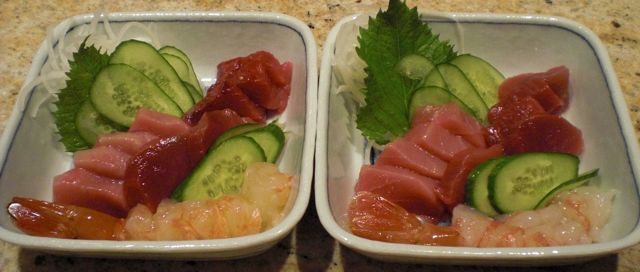We were deprived of good sushi and sashimi this summer for various reasons. Finally we stopped by our Izakaya substitute, Tako Grill, and enjoyed sake and food, especially seki-saba 関サバ but this "tease" of Japanese food left us wanting more. Then I received an e-mail announcing that Catalina was having a special on several of their products. The targeting of the e-mail couldn't have been better aimed. We responded by ordering a feast of sashimi items from Catalina Offshore products. This time, we ordered fresh blue fin tuna 本マグロ, live amaebi 甘エビ ("live" at least when it was shipped--twitching when it arrived), uni 雲丹, and ankimo 鮟肝. Everything arrived in good condition. The bottom segment of the package had frozen ankimo packed with dry ice and a Styrofoam board separated the fresh fish compartment with plenty of ice packs still mostly solid. The amaebi was a bit too large to my taste (6 to a pound, see picture below) but for something still moving (albeit barely) about as fresh as it can be. The tuna is a 2 lb block with "chiai" 血合い, "akami" 赤身 and "chutoro" 中トロ but no "ootro" 大トロ (this block is toward the tail without a belly portion). As I mentioned, previously, you have to remove the chiai and skin and block out appropriate portions before preparing sashimi. (In my anticipatory zeal to get from tuna block to sashimi as quickly as possible without actually gnawing on the block itself I forgot to take pictures of this preparation process). For some reason, Catalina does not carry toro of fresh blue fine tuna any longer but only frozen Ootoro.
Here are two sashimi servings to start.

It is an amateurish presentation, or you can say, a true Izakaya style rustic presentation; chutoro (left), akami (right) and amaebi (front). Since amaebi (more like botan ebi or spotted prawn) was large, after removing the head, shelled, and deveined, I cut it into small pieces. It was a cross between Iseebi 伊勢エビ and amaebi and was very sweet with firm texture and was excellent. The akami and chutoro were very fresh and likewise excellent, although it may not be the very best we ever had.
You can see how big these amaebis are. We used to get amaebi from the company in Alaska but Catalina has much fresher (mostly alive as I mentioned) and better.
The only problem is that the shrimp heads are too big for deep frying so I made shrimp head miso soup. Some disassembly required for the shrimp head, and nothing delicate about it, you have to use your fingers; to begin, suck out the goodies from the bottom of the head, then dismantle and enjoy all the small bits you can find (whatever than may be). One thing we can say is that the Uni from Catalina is the best, even compared to those we had in Hokkaido or elsewhere in Japan. This is absolutely the best in our opinion; from California, creamy, flavorful and fresh. We had an uni donburi ウニ丼 (sushi rice - with a good amount of vinegar of course - chiffonade of perilla 大葉 and nori 海苔 with a small dab of real wasabi on the top. We did not even need soy sauce since it had such good flavor.
I think we may OD on sashimi in the next few days. (Two pounds of tuna sashimi and 4 trays of uni are quite a lot for two. Although we did justice to the amaebi, in a surprisingly short period of time). But this is exactly the "fix" we needed.



